AN ABUNDANCE OF EARLY SPRING FLOWERING PLANTS
SIGNALS THE CYCLICAL CHANGE OF SEASONS
AT CASITAS DE GILA GUESTHOUSES IN SOUTHWEST NEW MEXICO
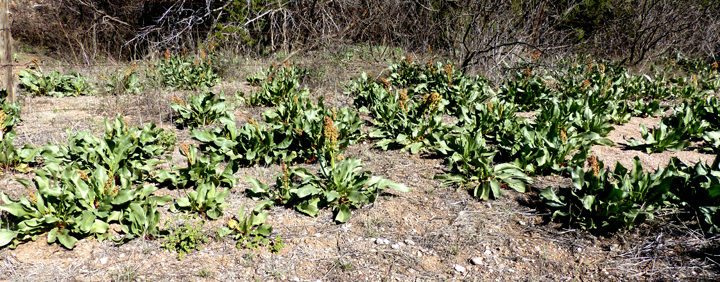
at Casitas de Gila Guesthouses
THE FIRST WET SPRING IN SEVERAL YEARS BRINGS ON THE FLOWERS
The landscape surrounding Casitas de Gila Guesthouses is classified as High Chihuahuan Desert (4,200 to 6,500 feet), an ecologic zone in which Juniper and Pinon conifers are the dominant trees. Temperature and precipitation are highly variable in the High Chihuahuan Desert, typically ranging between –5° and 105° Fahrenheit with between 6 and 30 inches of precipitation annually.
As discussed in the January 2015 Blog, both temperature and precipitation during the winter months in the Southwest are strongly influenced by the cyclical pattern of the warm versus cool phases of equatorial surface waters in the Pacific Ocean, known as El Niño Southern Oscillation (ENSO), where the warm phase, El Niño, results in warmer temperatures and more precipitation, and the cool phase, La Niña, results in cooler temperatures and less precipitation. Since 1950, the U.S. National Weather Service Climate Prediction Center monitors have been monitoring these oscillations between El Niño and La Niña events on a monthly basis to produce the Oceanic Niño Index (ONI). Examination of this Index prior to 2015 reveals that for the previous four Winter and Spring seasons, the El Niño Southern Oscillation has been either in a La Niña or the transitional Neutral (La Nada) phase, resulting in cold and dry conditions throughout the Southwest. Consequently, during these years there has been a general paucity of Spring flowers here at the Casitas. Then, beginning in November and December of 2014, and continuing through March 2015, the Index passed into a weak El Niño situation with accompanying warmer temperatures and a significant increase in precipitation, producing a total of 3.99 inches of rain since January 1. As a result, for the first time in several years there is an abundance of early Spring Flowers at the Casitas!
TO BLOOM OR NOT TO BLOOM: FOR SPRING FLOWERS
OF THE GILA HIGH-DESERT COUNTRY, WINTER MOISTURE IS THE KEY
For many perennial native plants of the Gila High-Desert Country there is a critical threshold of moisture received over the Winter months that determines whether or not a particular species will put out flowers in the Spring. If that threshold is not reached, some of these plants will not appear until later in the year, such as during the Summer Monsoon season, when the right amount of moisture is received and they start growing, putting out leaves, and if time before first frost permits, perhaps flower. Also, for some annual species, if a certain Winter moisture threshold is not attained, the seeds of the plant will not even germinate, let alone bloom. Instead, the seeds will remain dormant, waiting for the day, month, year, or in some cases even several years until that critical moisture threshold is reached.
Temperature is much less a factor in determining plant germination, growth, and flowering in the high desert, since 30° to 50° daily temperature swings are common throughout the year. As a result, all plants are well adapted to a wide range of and sudden change in temperature.
SOME OF THE EARLIEST SPRING FLOWERS TO APPEAR AND BLOOM AT THE CASITAS
CANAIGRE OR SAND DOCK (Rumex hymenosepalus)
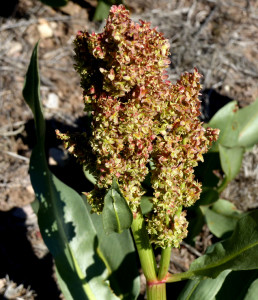
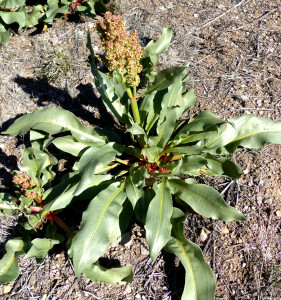
The earliest plant to appear in the Spring at Casitas de Gila is the perennial commonly known as Canaigre or Sand Dock, which is found throughout most of the Western States. Canaigre is found at the Casitas on the sandy first and second creek terraces immediately adjacent to the Bear Creek floodplain. Regardless of the amount of moisture received over the winter, this plant will always put up at least a few thick, long, elliptical-shaped leaves with tall, reddish colored stems, even during the dry La Niña Winters in late February or early March, and even when the nighttime temperatures are still below freezing. If sufficient rain is received over the Winter, the plant will flower in the form of a tightly packed panicle-type inflorescence of tiny, reddish flowers on a tall red stem.
USES
(Note: Most of the uses mentioned in this blog have been derived from the University of Michigan Native American Ethnobotany Data Base, an exceptional collection of numerous ethnobotanical reports and studies dating from the late 1800s to modern times that documents plants used by Native Americans.)
Canaigre has been used by many different cultures in many different ways for thousands of years, including: a good source of tannin for leather tanning (roots); a brown, yellow, or green dye for textiles (roots); medicinal purposes (roots, leaves and stems); and as an edible vegetable (roots, leaves and stems). The plant was used extensively by Native Americans in a variety of ways including:
Medicine
• Dermatological aid: stems and leaves used as a wash for sores, ant bites, and infected cuts; dried powdered root used on sores
• Burns: dried, powdered root
• Cold remedy: root chewed
• Sore throat or cough: infusion of roots used as a gargle; powdered or whole piece of root held in mouth
• Sore gums: root held in mouth
• Stimulating flow of milk: Cold infusion of root
• Diarrhea: RootCeremonial medicine
• Pollen sprinkled on ceremonial itemsFood
• Juicy stalks eaten as greens
• Stems boiled to make a drink before flowers bloom
• Seeds parched with hot coals, pounded and cooked to make thick gravy; mush or dough made into flat cakes and baked
• Stems boiled with sugar or roasted to be eaten hot or cold
• Leaves roasted in ashes or boiled and served with butter, or chopped and fried with mutton grease
• Stems baked and eaten
• Roots used as chewing gum
• Stems boiled, strained, flour and sugar added, and used as filling for baked piesDye for textiles and basket making
• Roots boiled or dried and ground to make dyes – brown, orange, green, red, and yellow, and goldTanning Hides
• Roots boiled for tanning hides
GOLDEN SMOKE (Corydalis aurea)
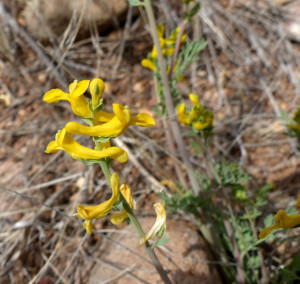
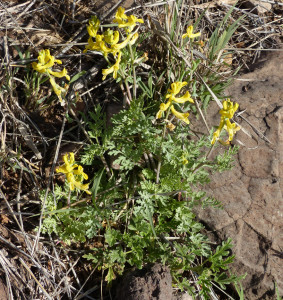
Golden Smoke is a beautiful early-Spring annual plant having highly dissected leaves with round-lobed segments and bright yellow flowers that occur singly, in pairs, or in loose racemes, with as many as 30 separate flowers on a short stem. At the Casitas this plant can be found just about anywhere, whether growing on the hillsides behind the buildings, the rocky sides of Bear Creek Canyon, or across the flats above the Canyon.
USES
Golden Smoke has been used by Native Americans and modern cultures for medicinal purposes for both humans and livestock, including:
• Diarrhea
• Sores on hands
• Infections during childbirth
• Bronchitis
• Sore throat
• Stomach aches
• Rheumatism
• Heart disease
• Snakebite in livestock
BLOODWEED (Plagiobothrys arizonicus)
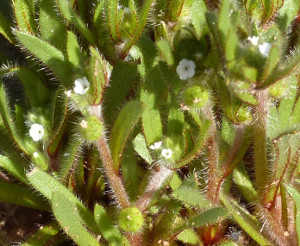
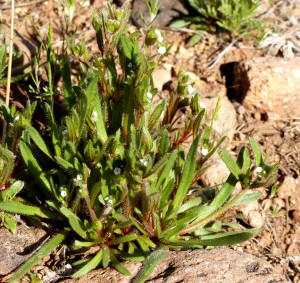
Bloodweed is a small annual herb having tiny 3mm white flowers and slender, elongated leaves with hairs that emerge along the margins. The leaves are red veined on the bottom side and exude a strong, persistent reddish-purple dye when crushed. Our horses will eat quantities of this little herb in the Spring, after which they look like they have put on lipstick! In times past, Native Americans used this plant to paint their body and face. Bloodweed can be very prolific in years when there is sufficient moisture. It is quite common on the flats around the Casitas.
RED-STEMMED FILAREE (Erodium cicutarium)
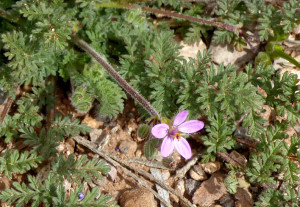
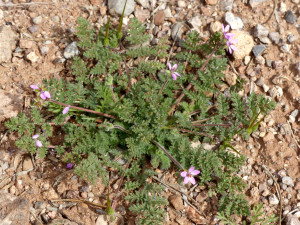
Red-stemmed Filaree is a small, ground hugging, herbaceous annual, a member of the Geranium family that is native to the Mediterranean region of Europe. It was introduced to the United States in California during the 1700s by the Spanish. Since then it has spread throughout the West. It is commonly found growing along with Bloodweed at the Casitas. Leaves are compound pinnate and are coated with small hairs. The small flowers are pink with five petals and a dark red center.
BLUE DICKS OR WILD HYACINTH (Dichelostemma capitatum)
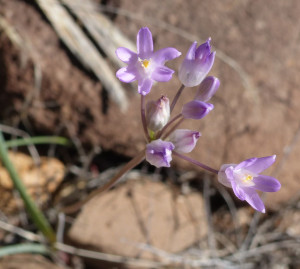
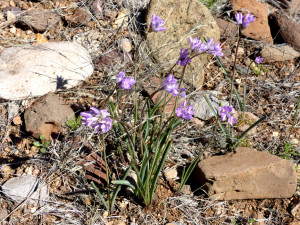
Blue Dicks is a herbaceous perennial that grows from an underground bulb-like swelling on the stem known as a corm. Corms function as storage organs for water and nutrients to allow a plant to survive during adverse climatic conditions in the Winter, or, as is the case of the Blue Dicks, Summer droughts and heat. This flower is quite conspicuous against the dead, dry brown grass of the previous summer, perched at the top of a thin, delicate, vertical stem that rises up to a foot or more in height from the ground where several thin elongated linear leaves form the basal foliage of the plant. The plant reproduces by seeds and by small cormlets, which are small reproductive growths that are attached to the parent corm by stolens at old leaf bases. Following a wet Winter, Blue Dicks are found in abundance over the hills and flats surrounding the Casitas.
USES
Blue Dicks were a major Spring food source for Native Americans throughout the West, particularly in the Spring before other plant foods were available. Flowers were eaten raw. The corms were eaten raw, steamed, boiled, baked, roasted, or dried for future use by grinding into flour. In some tribes, they were prepared as baby food or as snack food for children. It is reported that Native Americans practiced sustainability for this food source by breaking off the cromlets from the harvested corm and replanting them, as well as harvesting the corms after the plants went to seed and replanting the seeds in the hole where the corm was removed.
RATTLESNAKE WEED (Chamaesyce albomarginata)
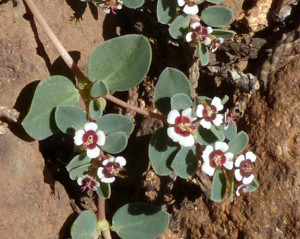
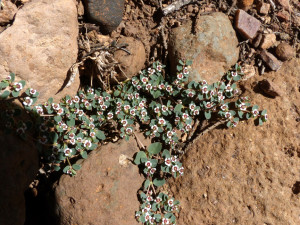
Rattlesnake Weed is an inconspicuous, very small, annual herb that grows in a flattened form over the ground. It has small, round, dusty looking, dark green leaves with a very thin lighter green border. The small flowers have burgundy centers with white ringed margins that form a cup shape. It is found in abundance over the flats, hills, and trails at the Casitas.
USES
This little plant is another of the many medicinal plants treasured by Native Americans and was used for quite a variety of ailments, including:
• A poultice of ground leaves and flowers, or a decoction of leaves, for snake bites, for use on both humans and livestock
• Crushed whole plant rubbed on sore eyes
• Decoction of plant used on sores
• Cold infusion for treating stomachache
• Poultice used as a hemostatic agent
• Leaves and roots eaten to promote lactation
• Decoction of plant used as a tonic for general debility
STEMLESS EVENING PRIMROSE (Oenothera caespitosa)
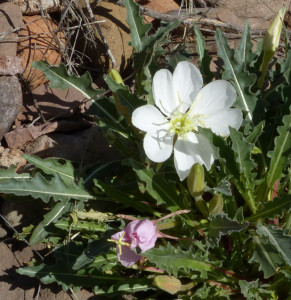
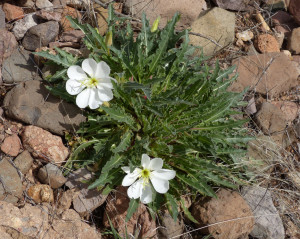
Stemless Evening Primrose is a very common and photogenic perennial that has elongate grayish-green leaves with crenated margins. The flower consists of four heart-shaped white petals that turn pink with age. The Stemless Evening Primrose seems to have a definite Winter moisture received threshold that must be attained if the plant is to bloom in the Early Spring. If that threshold is not attained, it will not bloom that spring, although it might flower with the coming of the Monsoon Rains in the Summer. With the abundant rain received over the Winter this year, it was one of the first flowers to appear.
USES
Like many of the Early Spring flowers, the Stemless Evening Primrose has been an important medicinal plant of the Native American pharmacopoeia, including:
• Wet poultice of crushed roots for used on sores and swelling
• Poultice of dried ground leaves used on sores for rapid healing
• Dried plant used as dusting powder for chafing
• Poultice of ground plant for prolapses of internal organs
• Medicine for sore eyes
• Medicine for toothache
BANANA YUCCA (Yucca baccata)
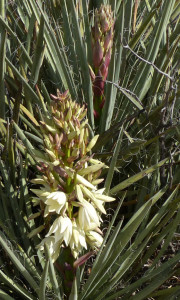
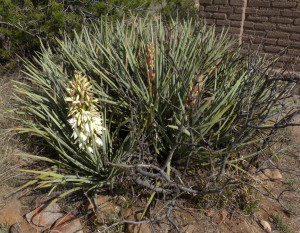
The Banana Yucca is easily distinguished from the Soaptree Yucca (Yucca elata) by its absence of a stem and low profile, where both leaves and flower stalks are found growing near the ground. Also, the bluish-green leaves are considerably wider, thicker, and have twisted fibers on the margins. The Banana Yucca requires much more Winter precipitation than the Soaptree Yucca if it is to flower in the Early Spring. The white to cream-colored flowers are considerably larger than those of the Soaptree Yucca and occur in dense, compact clusters on short two- to three-foot stalks, unlike the more spatially separated flowers found on the eight- to twelve-foot stalks of the Soaptree Yucca. After flowering, large, cylindrical, fleshy, green-colored fruits appear, that are 3 to 7 inches long and 2-1/2 inches thick. These fruits, sweet when ripe, are a much-sought-after delicacy by animals (especially deer) and insects, as well as by Native Americans in times past. As such, it is rare that they survive long enough to ripen on the plant! The range of the Banana Yucca is widespread, being found at all elevations from 4,000 in the lowland deserts to 7,000+ feet in the mountains. Here at Casitas de Gila there is large, tight cluster of 12 plants right next to Gallery. This March all 12 of the plants have put up stalks of flowers. It will be interesting to watch what happens when the fruits appear!
USES
In doing the research on usage for the various plants considered in this blog, it quickly became obvious that for the Native Americans of the Southwest, the Banana Yucca was the General Store or Wal-mart of its day. The University of Michigan Ethnobotanical Data Base lists 222 separate citations from the literature regarding use of Yucca baccata by Native Americans. Examination of these citations show that such use was widespread amongst most, if not all, of the various indigenous tribes living where the plant was found. Major uses included the following:
Medicinal
• Dermatological aid for washing hair
• Infusion of pulverized leaves taken as an emetic to induce vomiting
• Fruits eaten raw as a laxative or purgative
• Treating heartburn
• Juice from root used to lubricate midwife’s handsFood
• Dried fruits dissolved in water to make a beverage or a paste
• Fruit soaked, cooked, and made into a syrup
• Fruits eaten raw, baked, or boiled
• Fruits roasted or dried and rolled into loaves or cakes for winter use
• Fruits baked and pounded into a pulp and strained to make a beverage
• Leaves cooked and used in soup
• Flowers eaten as vegetable before Summer rains, after which they become bitter
• Fruits dried and used as trail staple when on warpath
• Fruits dried and ground to make a porridge
• Fruits used to make jelly and preserves
• Seeds of fruit dried and used for foodUtilitarian
• Leaf juice used as a medium for pigments of pottery paints and slips
• Leaf fibers used to make cordage, such as ropes, string, and twines
• Leaves used for making baskets
• Small roots used for making baskets
• Leaf fibers used to weave into mats
• Leaf fiber used to make fishing nets
• Leaves reduced to fiber and made into cloth
• Leaf fibers used to make small brushes for pottery decoration
• Leaf slivers used to make paint brushes and hair brushes
• Leaf fibers used to make snowshoes
• Leaves crushed and mixed with water to make soap
• Roots pounded and mixed with water to make soap
• Terminal spines on leaves used as needlesCeremonial
• Suds of root used for ceremonial purification baths
• Infusion of root used as a wash in adoption and name-giving ceremonies
• Leaves used as whips during initiations
• Leaves used to make ceremonial drumstick
SILVERLINE LOCOWEED (Astragulus tephrodes)
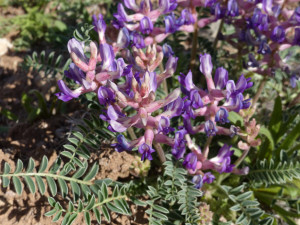
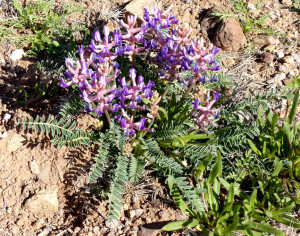
Silverline Locoweed is one of the earliest flowering plants to emerge in the Spring around the Casitas. It has compound leaves with a large number of small, folded, whitish-rimmed, elliptical-shaped leaflets. Its tubular purple and pink flowers are clustered tightly on long stems. Once the flowers bloom they are replaced by distinctive, large, bladder-like seed pods. While the plant is beautiful to look at, it is one of the 270 range plants of New Mexico that are know to be poisonous and toxic to livestock. The toxin in Silverline Locoweed is the alkaloid phytotoxin called swainsonine which causes a variety of neurological disorders in livestock, including cattle, sheep, and horses.There are three primary genera and several species of plants in the plant family Fabaceae which contain swainsonine, and in North America several of them are called locoweed or crazyweed. The main problem with locoweed is that the plant emerges well before range grasses and other forage plants in the Spring. Thus, hungry animals that are loose on the range are likely to eat it because it is the only thing available. In small amounts the plant is not that problematic. However, the plant tends to be somewhat intoxicating, and as a result some animals will become addicted to it, leading to severe neurological damage, and causing them to act unpredictably, erratically, or just plain crazy. Hence, the term locoweed.
DESERT BUCKTHORN OR DESERT BUCKBRUSH (Ceanothus pauciflorus; Syn. Ceanothus greggii)
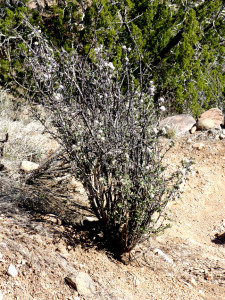
The Desert Buckthorn is a small shrub generally consisting of a dense thicket of several small trunks, branches, and numerous twigs, bearing small, elliptical-shaped, and leathery leaves. With sufficient Winter moisture, as was the case this year, Desert Buckthorn blooms in early Spring, producing thick, dense clusters of tiny, white flowers with five triangular-shaped petals that emit a rather overpowering fragrance that permeates the air of the surrounding area. For many people the smell is considered nauseating (although, over the last 17 years one does seem to get used to it!).
Around the Casitas, Desert Buckthorn is found along the dry washes and on north-facing hillsides which retain moisture longer, where it is browsed by Mule Deer, and when flowering, provides a popular nectar gathering spot for bees and butterflies. It is also abundant on higher elevations above the cliffs of Gila Conglomerate across from the Casitas on the east side of Bear Creek, where it is heavily browsed by the Rocky Mountain Bighorn Sheep that visit the cliffs periodically.
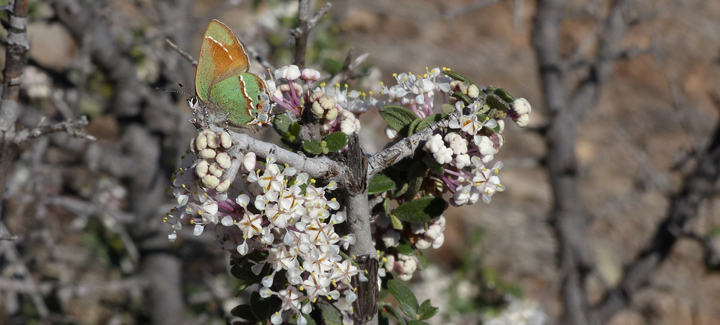
EARLY SPRING 2015: A GREAT YEAR FOR WILDFLOWERS
All of the photographs used in this blog were taken during March 2015. Indeed, it has been a great year for early Spring wildflowers … the best in several years. The plants and flowers discussed in this blog were the earliest bloomers and represent only about half of the species that were observed during the month. As the month progressed, just about every morning while hiking the various Casita trails it seemed that a new species would pop its head up, radiating a flowery “Hello, look at me”! And, what a joy it was to observe, photograph, and then identify and perhaps discover the ancient uses and connections that the Native Americans had with each of these plants. Oh, that we could know today all the Ancient Ones knew so long ago!


